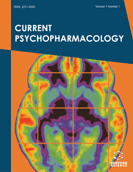Abstract
Background: Acute withdrawal symptoms in nicotine user predispose them to relapse during cessation attempts and pose difficulty in treatment of nicotine addiction. The present study was undertaken to explore the behavioral effects of azelnidipine in nicotine withdrawal model of mouse.
Method: Swiss albino mice (either sex; 20-25 g) were administrated with nicotine (3.35 mg/kg; s.c.) three times daily for seven days. Nicotine withdrawal was developed by the cessation of nicotine administration and the abstinence signs (rearing, grooming, head shake, jumping, leg licking and genital licking) were observed for 30 min on ninth day. Azelnidipine was administered (6, 9 and 12 mg/kg; p.o.) for seven days to separate groups of mice from 9th to 15th day of nicotine administration. On 15th day, the behavioral studies were carried out to investigate anxiety, memory and depression like behavior, respectively. Afterwards, brain thiobarbituric acid reactive substances (TBARS), reduced glutathione (GSH) levels and catalase activity were estimated.
Results: Nicotine abstinent mice showed marked (p < 0.05) signs of anxiety, impaired memory and depression-like symptoms. Nicotine abstinent mice showed increase (p < 0.05) in TBARS levels, decrease in GSH levels and catalase activity. However, azelnidipine administration not only decreased (p < 0.05) abstinence signs but also improved the behavioral scores of animals. Furthermore, AZD administration caused reduction in TBARS levels and enhancement in GSH levels and catalase activity.
Conclusion: Azelnidipine proves effective in the management of nicotine withdrawal symptoms owing to its calcium channel antagonistic and antioxidant properties.
Keywords: Nicotine withdrawal, azelnidipine, oxidative stress, calcium, antioxidant properties, catalase activity.
Graphical Abstract
Current Psychopharmacology
Title:Calcium Channel Blocker Ameliorates Nicotine Withdrawal Symptoms in Mice
Volume: 7
Author(s): Shikha Aggarwal and Nitin Bansal*
Affiliation:
- Department of Pharmacology, Amar Shaheed Baba Ajit Singh Jujhar Singh Memorial College of Pharmacy, Bela, Ropar,India
Keywords: Nicotine withdrawal, azelnidipine, oxidative stress, calcium, antioxidant properties, catalase activity.
Abstract: Background: Acute withdrawal symptoms in nicotine user predispose them to relapse during cessation attempts and pose difficulty in treatment of nicotine addiction. The present study was undertaken to explore the behavioral effects of azelnidipine in nicotine withdrawal model of mouse.
Method: Swiss albino mice (either sex; 20-25 g) were administrated with nicotine (3.35 mg/kg; s.c.) three times daily for seven days. Nicotine withdrawal was developed by the cessation of nicotine administration and the abstinence signs (rearing, grooming, head shake, jumping, leg licking and genital licking) were observed for 30 min on ninth day. Azelnidipine was administered (6, 9 and 12 mg/kg; p.o.) for seven days to separate groups of mice from 9th to 15th day of nicotine administration. On 15th day, the behavioral studies were carried out to investigate anxiety, memory and depression like behavior, respectively. Afterwards, brain thiobarbituric acid reactive substances (TBARS), reduced glutathione (GSH) levels and catalase activity were estimated.
Results: Nicotine abstinent mice showed marked (p < 0.05) signs of anxiety, impaired memory and depression-like symptoms. Nicotine abstinent mice showed increase (p < 0.05) in TBARS levels, decrease in GSH levels and catalase activity. However, azelnidipine administration not only decreased (p < 0.05) abstinence signs but also improved the behavioral scores of animals. Furthermore, AZD administration caused reduction in TBARS levels and enhancement in GSH levels and catalase activity.
Conclusion: Azelnidipine proves effective in the management of nicotine withdrawal symptoms owing to its calcium channel antagonistic and antioxidant properties.
Export Options
About this article
Cite this article as:
Aggarwal Shikha and Bansal Nitin *, Calcium Channel Blocker Ameliorates Nicotine Withdrawal Symptoms in Mice, Current Psychopharmacology 2018; 7 (2) . https://dx.doi.org/10.2174/2211556007666180403114258
| DOI https://dx.doi.org/10.2174/2211556007666180403114258 |
Print ISSN 2211-5560 |
| Publisher Name Bentham Science Publisher |
Online ISSN 2211-5579 |
 17
17
- Author Guidelines
- Bentham Author Support Services (BASS)
- Graphical Abstracts
- Fabricating and Stating False Information
- Research Misconduct
- Post Publication Discussions and Corrections
- Publishing Ethics and Rectitude
- Increase Visibility of Your Article
- Archiving Policies
- Peer Review Workflow
- Order Your Article Before Print
- Promote Your Article
- Manuscript Transfer Facility
- Editorial Policies
- Allegations from Whistleblowers
- Announcements
Related Articles
-
Functional Role of Lipoprotein Receptors in Alzheimers Disease
Current Alzheimer Research Clinical Effectiveness of a High Dose Versus the Standard Dose of Meropenem in Ventilator-associated Pneumonia Caused by Multidrugresistant Bacteria: A Randomized, Single-blind Clinical Trial
Infectious Disorders - Drug Targets Retinal Imaging: A New Tool for Studying Underlying Liability to Cardiovascular Disease in Schizophrenia
Current Psychiatry Reviews Chalcones in Cancer: Understanding their Role in Terms of QSAR. II Part
Mini-Reviews in Medicinal Chemistry Selected Herbals for Sports Injuries
The Natural Products Journal Mechanisms of Mononuclear Phagocyte Recruitment in Alzheimers Disease
CNS & Neurological Disorders - Drug Targets CADD Modeling of Multi-Target Drugs Against Alzheimer's Disease
Current Drug Targets Energizing Genetics and Epi-genetics: Role in the Regulation of Mitochondrial Function
Current Genomics 1'-methylspiro[indoline-3,4'-piperidine] Derivatives: Design, Synthesis, Molecular Docking and Anti-tumor Activity Studies
Letters in Drug Design & Discovery Endoplasmic Reticulum Stress as a Novel Therapeutic Target in Heart Diseases
Cardiovascular & Hematological Disorders-Drug Targets Plasma Clusterin as a Potential Biomarker for Alzheimer’s Disease-A Systematic Review and Meta-analysis
Current Alzheimer Research Prescription Opioid Abuse and its Potential Role in Gross Dental Decay
Current Drug Safety Chemical Intolerance
Current Rheumatology Reviews The Cerebrospinal Fluid Amyloid β42/40 Ratio in the Differentiation of Alzheimers Disease from Non-Alzheimers Dementia
Current Alzheimer Research Use of Caffeine and Nicotine in People with Schizophrenia
Current Drug Abuse Reviews Rheumatoid Arthritis: An Evolutionary Force in Biologics
Current Pharmaceutical Design Common Neurogenetic Diagnosis and Meso-Limbic Manipulation of Hypodopaminergic Function in Reward Deficiency Syndrome (RDS): Changing the Recovery Landscape
Current Neuropharmacology Novel Isocyanide-Based Three-Component Synthesis of Substituted 9Hfuro[ 2,3-f]chromene-8,9-Dicarboxylates in Water
Combinatorial Chemistry & High Throughput Screening The Cannabinoids Switch of Oxidative Stress: A Double-Edged Sword
Mini-Reviews in Organic Chemistry Metabotropic Glutamate Receptors as Therapeutic Targets for Cognitive Disorders
Current Topics in Medicinal Chemistry


























